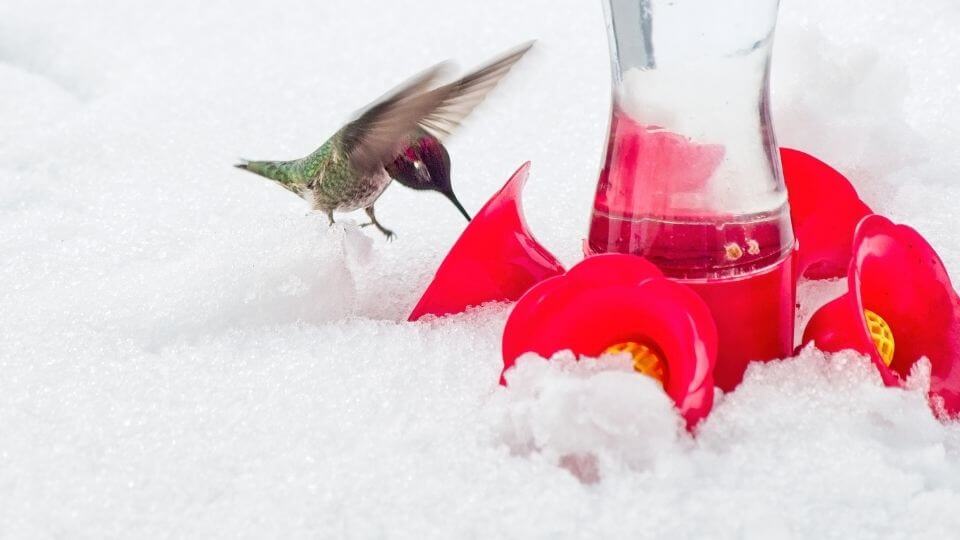Feeding hummingbirds during the winter is possible, but it requires a lot of commitment since the feeds and nectar hung in the feeders can freeze.
A hummingbird heater is a convenient and simple-to-use solution to keeping feeders from frosting over in the cold winter. During these times, winter hummingbirds use their wings to insulate their body heat and protect themselves from the cold. When the temperatures fall below 27 Fahrenheit, however, the nectar in the feeders also begins to freeze.
When hummingbirds drink such cold liquids, it can be fatal as the birds can experience a “brain-freeze,” causing them to faint or fall off the perch.
Table of Contents
Are There Heaters for Hummingbird Feeders?
Yes. Ahummingbird feeder heater is a popular alternative used by birdwatchers; it is typically adjustable and fits on various hummingbird feeders for outdoor environments. Hummingbird heaters are designed to fit an incandescent lightbulb (7-watt or 15-watt) to keep nectar and hummingbirds warm throughout the winter months.
A good feeder heater should be easy to use, fill, and clean. There are several types of hummingbird heaters available that come assembled and others that would need to be assembled separately. Blown glass hummingbird feeders are one of the best feeders that will react well with constant heat from a lightbulb, but it would require a heating element to be added to it.
Traditional Hummingbird heaters (that come assembled) guarantee less swapping out of frozen nectar. The heaters also give birders an easy time as they no longer have to worry about their bird feeders freezing when no one is home.
 California. class=”wp-image-115″/>
California. class=”wp-image-115″/>What Temperature Is Too Cold for Hummingbirds?
Temperatures that reach 40-50 degrees Fahrenheit is the type of weather that will prompt Hummingbirds to go into “Torpor”, their period of hibernation, to converse their energy. Hummingbirds are likely to survive a winter freeze-over if there are reliable food sources.
The Hummingbird heaters are highly effective as they can keep the feeders thawed even when temperatures go below 10 F or -12 C with just a 7-watt bulb or a 15-watt bulb. Placing the feeders away from windy areas will help reduce electricity consumption.

Should I Heat My Hummingbird Feeder ?
Yes, If you experience weather below 40 degrees Fahrenheit any local hummingbirds are likely to visit your feeder to keep warm and get to a source of nourishment. In Georgia, for instance, the Department of Natural Resources encourages birders to leave out their hummingbird feeders for the sake of the other migrating hummingbirds that may be trying to escape the cold weather.
Since the Hummer heater uses about 7 watts, the heater requires only requires a small cost for maintenance and electricity per day. This heat keeps the nectar from freezing without getting it too warm. In cold climates, feeders can freeze, and the nectar in the feeder will freeze. Placing a hummingbird heater could more easily help warm the bird feeder.

How Can I Heat My Hummingbird Feeder ?
Feeders should be heated to keep them from freezing, especially in the winter. Placing a 7-watt incandescent light bulb will help warm the
Some hummingbird feeders require more heat, but the smaller feeders still work well with 7-watt lightbulbs. Also, flat or round-shaped feeders with no air gaps at the bottom will maintain the most heat, thus promoting better warmth and nectar quality.
Other than artificial heaters, other DIY methods can keep the birds and nectar warm. Consider also insulating the top of the feeder to retain the warmth.
Hummer Hearth Hummingbird Feeder Heater
The “Hummer Hearth”
Using a “Hummer Hearth”

How Do You Keep Hummingbirds Warm in the Winter?
Using a typical Hummingbird heater that can be installed on your existing feeder or buying one with a heater element will help keep Hummingbirds and their food source warm.
A feeder heater’s essential function is to keep the inner temperatures warm; this will maintain a thawed source of nectar for Hummingbirds during any cold spells. The warmth of the feeder can also provide a place of refuge to a passing Hummingbird.
There will be warm sections for the hummingbirds to get heat for their bodies, which helps reduce the number of death amongst hummingbird populations during the cold winter seasons.
Hummingbird feeders are helpful for Anna’s Hummingbirds breeds as they do not travel during winter.

What Kind of Food Do Hummingbirds Eat in Winter?
Hummingbirds consume mostly insects, insect eggs, larvae, and spiders. These food sources provide protien and fat that are essential proteins for hummingbirds and their hatchlings.
You can attempt to help Hummingbirds with their protein intake by providing them with insects like: ants, aphids, beetles, gnats, and spiders.
Wild sources of protein for Hummingbirds include mites, mosquitoes, and wasps.
Hummingbirds feed almost every 10-15 minutes. They visit between 1,000-2,000 flowers each day in search of nectar.

Can Hummingbirds Drink Cold Sugar Water?
Frozen nectar limits the flow of nectar in the feeder, resulting in a shortage of nectar supply in the hummingbird feeders during the cold seasons. To solve this, birders opt to put heaters on specific feeders. These heaters provide warmth for the hummingbirds and prevent the nectar from freezing.
Hummingbird keepers prefer this alternative innovation because it effectively keeps the birds out of the periodic dangers of winter. The hummingbird heaters are also a convenient solution that prevents the hummingbird’s food and nectar from freezing.
One can opt to bring their feeder in at night to prevent the liquids from freezing and rehang fresh and warm feeds very early in the morning. This, however, can be tiresome and wasteful. Using an external heat source that is CSA approved to keep the feeds from freezing is the easiest method to keep the hummers alive.
Hummingbird heaters are an excellent solution to the low the nectar freezing problem in the hummingbird feeders as the heaters have been tested and proven to work even at temperatures of as low as 1 degree, and the food remained unfrozen.

